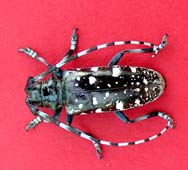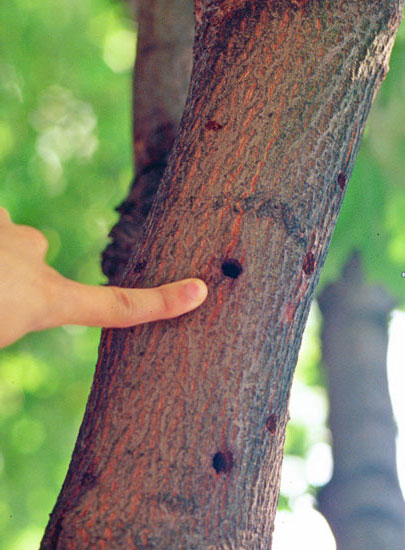
The Asian Longhorned Beetle

Overview:
- The Asian longhorned beetle is up to 1.5″ long with antennae that are 1 to 2 times its body length. It feeds on many species of hardwood trees.
- Adult beetles are active from early summer through mid-fall
- Adult females dig 1/2 inch diameter bowl-shaped holes in the bark to bury their eggs.
- The eggs hatch within 10 to 15 days and then the worm–like immature larvae tunnel under tree bark and bore into healthy hardwood trees.
- This tunneling damages and eventually kills the tree.
- Once a tree is under attack there is no treatment available, the tree has to be removed and disposed of in a specific way.
- Preventative treatment is the only method of dealing with this pest. Lueders Environmental is currently testing a treatment program that should be effective in protecting your trees against the Asian longhorned beetle.
Additional Information:
Signs of Asian longhorned beetle infestation include: perfectly round, dime-sized exit holes; a sawdust-like material comprised of tree shavings and insect waste; and oozing sap. Dead and dying tree limbs or branches and yellowing leaves when there has been no drought also signal Asian longhorned beetle infestation.
While the Asian longhorned beetle can fly for distances of 400 yards or more in search of a host tree, they tend to lay eggs in the same tree from which they emerged as adults, migrating only when population density becomes too high. During the summer months, a mated adult Asian longhorned beetle female chews 35 to 90 individual depressions into the host tree’s bark and lays an egg in each of the pits. The eggs hatch in 10-15 days and the white, caterpillar-like larvae tunnel into the tree’s phloem and cambium layers beneath the tree bark. After several weeks, the larvae tunnel deeper in the tree’s heartwood where it feeds on the tree’s nutrients. The tunneling damages and eventually kills the tree. As they mature to pupae they hatch into adults inside the tree over the winter months. The full-grown adult Asian longhorned beetles chew their way out of the tree the next spring and summer, as early as May and as late as October or November. In the process, they leave perfectly round exit holes that are approximately 1/2″ in diameter.
Although research is underway to determine the effectiveness of certain insecticides no thoroughly proven material or biological control methods are currently available. However, Lueders Environmental, Inc., is currently utilizing a treatment program that it expects will prove effective in protecting your selected trees against the Asian longhorned beetle.

Winter Moth
Winter moth feeds on and defoliates a wide range of deciduous hosts, including maple, oak, cherry, apple, crabapple trees, as well as rose bushes and blueberry plants.
 You will typically see the flight of the male moth, which begins in late November and can extend through December – hence the name winter moth. (Female winter moths are nearly wingless and do not fly.) Tree damage is caused by the caterpillars hatching in the spring and then burrowing into the leaf buds to feed. Once the bud opens, you will see holes in the leaves from the “caterpillar bud feeding”.
You will typically see the flight of the male moth, which begins in late November and can extend through December – hence the name winter moth. (Female winter moths are nearly wingless and do not fly.) Tree damage is caused by the caterpillars hatching in the spring and then burrowing into the leaf buds to feed. Once the bud opens, you will see holes in the leaves from the “caterpillar bud feeding”.
Treatment for this pest begins in spring with an environmentally friendly biological material to control caterpillar eggs. Two visits are generally needed so that treatment should sometimes be followed with a second treatment in late spring that is applied as the caterpillars emerge from the buds. (We don’t simply go after the moths in the fall because what you see flying are the males and they are not the problem – it is the caterpillars in spring that cause damage.) Since winter moths can damage trees of all sizes Lueders has specialized equipment that can reach heights of 100 feet ensuring protection for even the largest of trees.
Should you see extensive moth activity in late fall or caterpillars in your trees in early spring please call us as soon as possible so that we can provide you with a free analysis of your property before your trees and shrubs suffer significant damage.
Hemlock Woolly Adelgid Update
Hemlock Woolly Adelgid continues to expand its presence in Massachusetts. You can identify it by the white cottony mass on the underside of the needles as shown in the accompanying photograph.
 Early identification and controls, including environmentally friendly horticultural oil applications during the fall and spring along with maintaining plant health are your best weapons against this pest. Left unchecked the woolly adelgid can kill Hemlocks in a few years. It is often thought that cold winters control this pest but recent experience shows that this is not the case.
Early identification and controls, including environmentally friendly horticultural oil applications during the fall and spring along with maintaining plant health are your best weapons against this pest. Left unchecked the woolly adelgid can kill Hemlocks in a few years. It is often thought that cold winters control this pest but recent experience shows that this is not the case.
Hemlocks generally are used as noise and privacy screens so are important to your landscape. Lueders is happy to provide you with a no-cost assessment of the health of your hemlocks and recommendations for treatment if needed.
